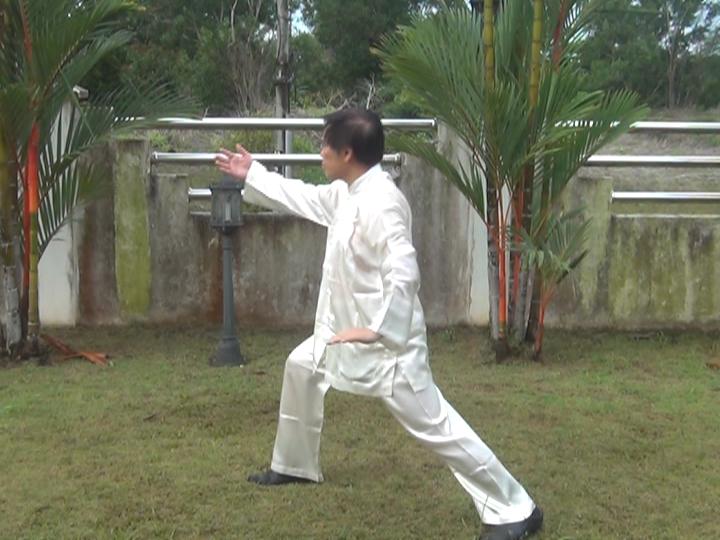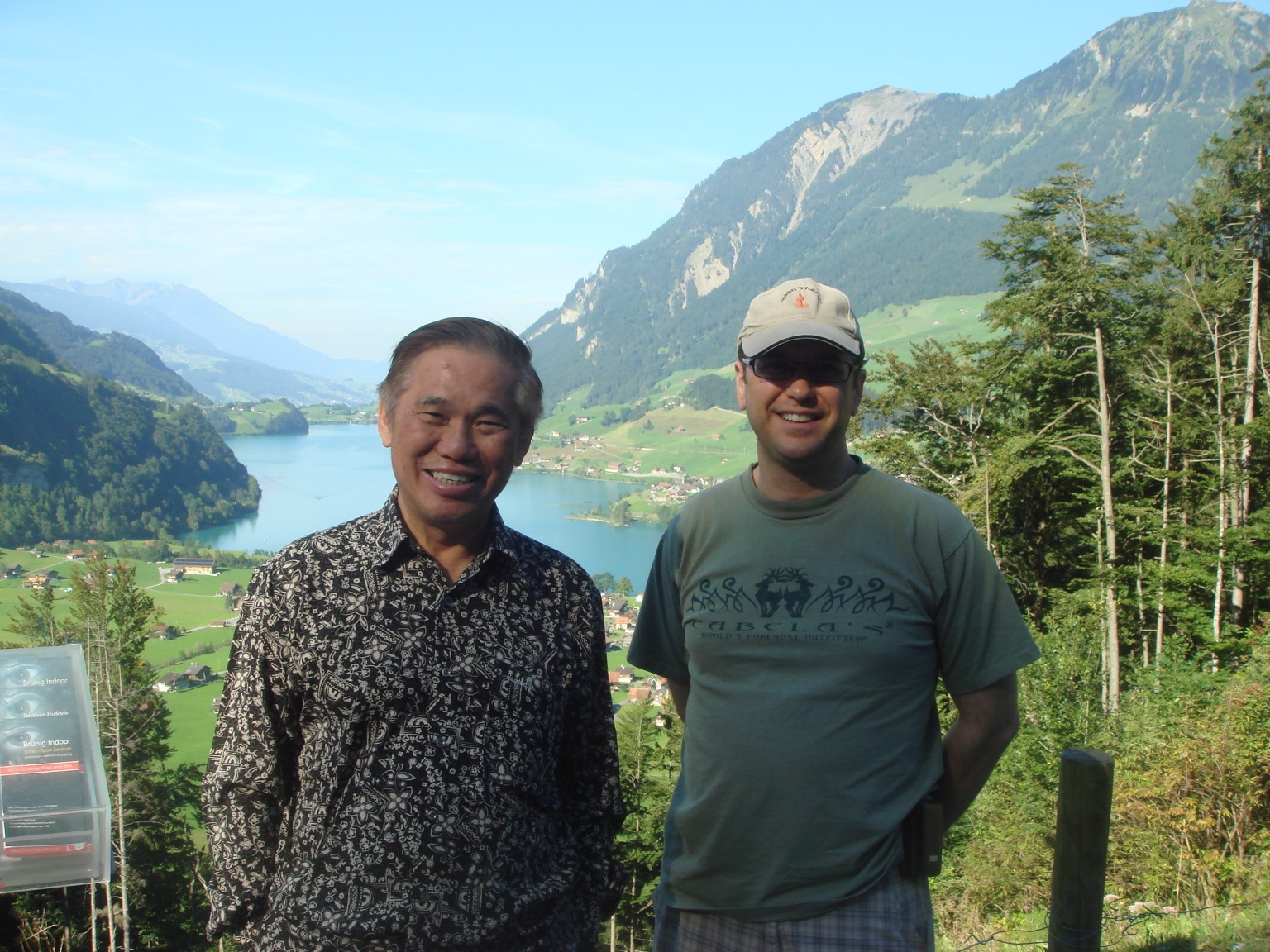CHI KUNG AND TAIJIQUAN

The whole Taijiquan set is chi kung
Question 4
Do we in Wahnam tradition adopt any Chi Kung exercises that are traditionally done by Yang Style practitioners, or do we replace these with Shaolin Chi Kung?
What Shaolin Chi Kung techniques and skills are particularly relevant for the correct practice of Yang Style Tai Chi Chuan and does their effectiveness depend on the level of practitioner?
I was also wondering how to recognize a suitable / competent Yang Style teacher.
Jacek
Answer
No, we in Shaolin Wahnam do not adopt any chi kung exercises that are traditionally practiced by Yang Style practitioners.
Any Taijiquan (Tai Chi Chuan) practitioners, including those from Yang Style, who adopt any chi kung exercise from anywhere as their main exercise to manage energy (this is what chi kung is) is tactically admitting that theirs is not genuine Taijiquan, though they may not realize it.
Taijiquan itself is chi kung. In other words, when one practices Taijiquan, he is practicing chi kung.
The Yang Style 108-Pattern Set is a set of chi kung with 108 chi kung exercises. The Eighteen Lohan Hands is a set of chi kung with 18 chi kung exercises. Sinew Metamorphosis is a set with 12 chi kung exercises.
In our school, any kungfu set is also a chi kung set. The Flower Set is a set with 72 chi kung exercises, with some repetitions. Flowing Water Floating Clouds is a set with 108 chi kung exercises, again with some repetitions.
In other words, you can take any one or more patterns from the Yang Style 108-Pattern Set, Flower Set or Flowing Water Floating Clouds – just like you can take any one or more patterns from Eighteen Lohan Hands or Sinew Metamorphosis – perform them a suitable number of times to generate a chi flow which will give you good health, vitality and longevity.
For example, you may choose just one pattern, “Lifting Water”, practice it about 20 times to generate a chi flow. Or you may choose the five patterns in “Grasping Sparrow’s Tail”, practice them about 10 times each on the left and the right side to generate a chi flow. If you do this regularly, you will overcome pain, injury and illness if you have any, including those that you may not be aware of, and you will have good health, vitality and longevity. It is worthwhile to remind ourselves that it is the chi flow, not kungfu or chi kung patterns, that bring these benefits.
In his classic book on the Yang Style 108-Pattern Set, Yang Deng Fu recommended some chi kung exercises as supplementary practice. These exercises are similar to, but not the same as, the beginning movements in the Dragon Strength Set.
Some Yang Style instructors borrow chi kung exercises from elsewhere, but they do not teach or practice them as chi kung; they practice them as gentle physical exercise. Indeed some of them explicitly say these exercises are meant to loosen them, or as some sort of warming up. They do not realize that loosening or warming up is not the original objective of these chi kung exercises, and that as a wonderful martial art there is no need to loosen or warm up in Taijiquan. A Taijiquan practitioner, by training his Taijiquan and without borrowing anything from outside, is ready for action at any moment.
Not many people outside our school are aware that the chi kung derived from Taijiquan patterns is more powerful from the chi kung derived from exercises the general public normally classifies as chi kung, like those from Eighteen Lohan Hands and Self-Manifested Chi Movement.
This is understandable as Taijiquan is martial chi kung, which is two levels above Eighteen Lohan Hands which is health chi kung, and three levels above Self-Manifested Chi Movement which is medical chi kung. Chi kung masters in the past classified chi kung progress into five levels, namely medical chi kung, health chi kung, intellectual chi kung, martial chi kung, and spiritual chi kung.

If the chi kung in Taijiquan is more powerful than the chi kung in 18 Lohan Hands, for example, why a practitioner trains longer in Taijiquan than in some chi kung styles?
If chi kung from Taijiquan is more powerful that that from Eighteen Lohan Hands and Self-Manifested Chi Movement, why do I recommend Taijiquan training to be an hour whereas that in Eighteen Lohan Hands or Self-Manifested Chi Movement to be 15 minutes. Isn’t training more time in a more powerful chi kung expose practitioners to over-training. No. The reason is that the nature of training in these three types of chi kung is different.
Shaolin Chi Kung techniques and Yang Style techniques are noticeably different. The techniques or outward forms of Lifting the Sky and Double Dragons, for example, are different from the techniques of Grasping Sparrow’s Tail. If all other things were equal, Yang Style techniques are more cost-effective than Shaolin Chi Kung techniques in practicing chi kung, like generating an energy flow. This is a main reason why many people, without actually knowing what they say, refer to Yang Style as internal, and Shaolin, including Shaolin Chi Kung, as external.
The fundamental skills particularly relevant for the correct practice of Yang Style Taijiquan as well as of Shaolin Chi Kung or any internal art are the same. They are being relaxed and gently focused at the same time. These two skills collective as one is known as entering Tao in Taijiquan, entering Zen in Shaolin, entering a chi kung state of mind in chi kung in general, and attaining a heightened state of consciousness in modern language. This skill is essential. Without it, one cannot successfully practice chi kung, regardless of whether he performs Shaolin Chi Kung techniques, Yang Style techniques or any techniques.
The effectiveness of the techniques but more significantly of the skills, depends greatly on the attainment level of practitioners. The main reason, though most practitioners may not realize it, why more than 80% of Taijiquan and chi kung practitioners do not have the benefits their practice is meant to give is because they lack the minimum skill level even when they may perform the techniques correctly and beautifully.
Most Taijiquan practitioners cannot use their Taijiquan for combat because they lack combat skills even when they have the right techniques. Most Taijiquan and chi kung practitioners do not enjoy chi kung benefits like good health, vitality and longevity because they lack chi kung skills thought thei chi kung techniques are correct. If some practitioners do have good health, vitality and longevity, it is due to other factors, not due to their Taijiquan or chi kung practice.
After having the necessary skills, techniques become important in how much benefits practitioners get from their practice. In other words, after they are skillful in combat or in generating an energy flow, what techniques they choose and how well they perform them, determine how much more benefits they can get. But before this, i.e. before they have the fundamental skills for combat and for generating an energy flow, no matter how good their chosen techniques are and how beautifully they can perform the techniques, they may not derive any combat or chi kung benefits.
There are two excellent ways to recognize a suitable or competent Yang Style teacher, one to access his performance in the art he teaches, and the other to access his effectiveness in his teaching.
A competent teacher of Yang Style or any art must be a living example of the art he teaches. If he teaches Yang Style Taijiquan, he should be healthy as a result of his Yang Style practice, and he should be able to use Yang Style Taijiquan in combat. If he takes medication on a routine basis, and does not know what to do when an assailant punches him or grips his arm, he is not even a competent practitioner, and hence is unlikely to be a competent teacher.
To access his effectiveness as a teacher, you examine whether his students exhibit the benefits the art is meant to give. If the students look tired and stressful, and have no experience at sparring, then the teacher is not competent. If the students are full of life despite some tough exercise, and they employ Taijiquan techniques skillfully to overcome simulated combat situations, they indicate that their teacher is competent.
In the recently concluded Art of Teaching course, we classified teachers into four categories – bad, mediocre, good and great. The aim of the course was to train great teachers.
A bad teacher brings harm instead of benefit, like knee injuries. A mediocre teacher just teaches according to a syllabus, often without knowing whether his students can follow. A good teacher brings benefits the art is meant to give. A great teacher brings out the best in his students, not just in the art he teaches but in their daily life.
The guidelines above show a competent teacher ranging from mediocre to good. It will be fun for you to apply the above classification of teachers into four main types on Taijiquan and chi kung teachers today. It is even more important for you to apply the above answer to find a great teacher for yourself, or if you are already teaching, to make yourself into a great teacher.
Grandmaster Wong Kiew Kit
22nd December 2013

Competent Taijiquan teachers are examples of what they teach
The question and answer are taken from the thread Yang 108-Pattern Set: 10 Questions for the Grandmaster in the Shaolin Wahnam Institute Discussion Forum.
LINKS
Overview
